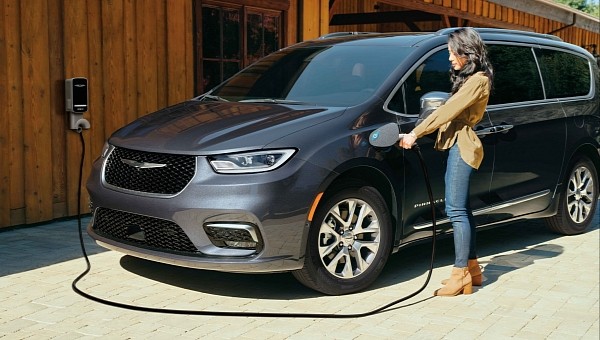Plug-in hybrid vehicles were considered an intermediate step toward fully-electric mobility and have become more popular in the past two years. Nevertheless, studies show that people used them improperly, negating all the benefits brought by the Li-Ion battery onboard.
Hybrid powertrains were all the rage ten years ago when people had few choices to show they cared for the environment. Thanks to an electric motor, they could save quite a lot of gas compared with a pure-ICE vehicle. Things were looking good, so car companies thought, why not push this even further with a plug-in hybrid? The main idea was to have a bigger battery with enough energy storage to power the electric motor for extended rides.
Things were great on paper. Most plug-ins allow driving in a purely electric mode for around 30 miles/48 km, which is more than most people need for their daily commute. Thus, the car would function most of the time as an electric vehicle. And when the need arises, it can travel long journeys without worrying about the range and charging stations. The best of both worlds, right?
Well, as with many things in life, what looks good in theory can work very differently in practice. Wise people noticed that plug-in vehicles are considerably more expensive than their ICE counterparts and even regular hybrids. At the same time, the saving potential was not comparable with the money paid extra. To make matters worse, most PHEVs don’t understand fast charging, and charging them takes hours. That’s why people usually give up charging them altogether and just use them normally.
The problem is that a plug-in hybrid still has a sizeable battery. When depleted, it’s just a useless heavy chunk of metal you need to carry around. It affects fuel economy and it affects the car’s handling. This makes a PHEV even less efficient than a “dumb” ICE vehicle. Not to mention that you pay a lot of money for the privilege of having that chunk of metal to carry in the first place.
All these problems have become obvious thanks to many studies done in different parts of the world. Similar research in the U.S. showed that plug-in hybrids were mostly in line with the EPA and NHTSA expectations regarding real-world electric drive share. Nevertheless, a recent study that considers more data from previously unexplored sources paints a different picture.
More specifically, according to the International Council on Clean Transportation (ICCT), PHEV owners drive their cars far less in purely-electric mode than the EPA assumes. The study takes into account self-reported fuel consumption from Fuelly.com and engine-off distance traveled collected by the California Bureau of Automotive Repair (BAR). The study shows that real-world electric drive share may be 26%–56% lower, and real-world fuel consumption may be 42%–67% higher than assumed within EPA’s labeling program for light-duty vehicles.
This might present a problem not only for the environment but also for regulators because many policies are based on the assumption that PHEVs are almost as clean as electric vehicles. This makes states subsidize the purchasing of plug-in cars and sometimes offer tax breaks and other incentives based on a false assumption. The EPA fuel efficiency is also estimated inaccurately, tricking people into thinking they buy a clean vehicle when in fact, they might never get the same economy figures in real-world driving.
Things were great on paper. Most plug-ins allow driving in a purely electric mode for around 30 miles/48 km, which is more than most people need for their daily commute. Thus, the car would function most of the time as an electric vehicle. And when the need arises, it can travel long journeys without worrying about the range and charging stations. The best of both worlds, right?
Well, as with many things in life, what looks good in theory can work very differently in practice. Wise people noticed that plug-in vehicles are considerably more expensive than their ICE counterparts and even regular hybrids. At the same time, the saving potential was not comparable with the money paid extra. To make matters worse, most PHEVs don’t understand fast charging, and charging them takes hours. That’s why people usually give up charging them altogether and just use them normally.
The problem is that a plug-in hybrid still has a sizeable battery. When depleted, it’s just a useless heavy chunk of metal you need to carry around. It affects fuel economy and it affects the car’s handling. This makes a PHEV even less efficient than a “dumb” ICE vehicle. Not to mention that you pay a lot of money for the privilege of having that chunk of metal to carry in the first place.
All these problems have become obvious thanks to many studies done in different parts of the world. Similar research in the U.S. showed that plug-in hybrids were mostly in line with the EPA and NHTSA expectations regarding real-world electric drive share. Nevertheless, a recent study that considers more data from previously unexplored sources paints a different picture.
More specifically, according to the International Council on Clean Transportation (ICCT), PHEV owners drive their cars far less in purely-electric mode than the EPA assumes. The study takes into account self-reported fuel consumption from Fuelly.com and engine-off distance traveled collected by the California Bureau of Automotive Repair (BAR). The study shows that real-world electric drive share may be 26%–56% lower, and real-world fuel consumption may be 42%–67% higher than assumed within EPA’s labeling program for light-duty vehicles.
This might present a problem not only for the environment but also for regulators because many policies are based on the assumption that PHEVs are almost as clean as electric vehicles. This makes states subsidize the purchasing of plug-in cars and sometimes offer tax breaks and other incentives based on a false assumption. The EPA fuel efficiency is also estimated inaccurately, tricking people into thinking they buy a clean vehicle when in fact, they might never get the same economy figures in real-world driving.










